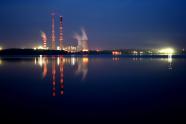Natural Gas Increases are Diminishing Carbon Emissions

U.S. carbon dioxide emissions are falling. Why?
New data by a governmental branch is saying that the
switch from coal to unconventional forms of natural
gas is the main reason, followed by an unusually
warm 2012 winter.
Coal-fired power, in fact, used to provide about
half of the electric generation market, and it is
now 34 percent. At the same time, natural gas from
shale is rising, providing almost as much fuel for
utilities as coal -- but certainly trending higher.
The result is fewer carbon dioxide emissions,
notably less than in previous years, says the
U.S. Energy Information Administration.
“Amid historically low natural gas prices and the
warmest March ever recorded in much of the United
States,
coal's share of total net generation dropped to
34 percent — the lowest level since at least January
1973,” says the agency. “Despite seasonally low
loads, natural gas-fired generation grew markedly
and accounted for 30 percent of overall net
generation by March 2012. Total electricity demand
fell this winter as warmer weather reduced home
heating requirements.”
The research goes on to say that modern
combined-cycle natural gas generation results in the
more efficient production of electricity. That has
contributed to fewer heat-trapping emissions, along
with the fact that natural gas has fewer pollutants
tied to it than does coal. The report also says that
about 90 percent of the carbon dioxide emissions
associated with energy production is from burning
coal.
Altogether, the Energy Information Administration is
reporting that carbon dioxide emissions are 2.4
percent less in 2011 than they were in 2010. They
are also 9.1 percent less than in 2007.
True, years of economic lag have meant that
commercial and industrial enterprises are demanding
less energy. But now those financial prospects and
numbers are starting to tick up. The decline in
carbon is therefore tied more to fuel switching than
anything else. It’s also associated with higher oil
prices, causing people to drive less -- something
that may also lead to more alternatively-fueled
vehicles.
The implications: Production from shale formations
has grown from a negligible amount just a few years
ago to almost 15 percent of total U.S. natural gas
production. By 2035, natural gas, generally, will
make up about 45 percent of the utility generation
market, says the Energy Information Administration.
With the new abundance and lower prices,
lower-carbon gas seems likely to play a much larger
role in the generation of electric power,” writes
Daniel Yergin, in his book “The Quest.”
Global Emissions
Certainly, green energy has its place. But if
environmentalists are concerned about rising
greenhouse gas emissions, why not welcome shale gas
development and promote better and safer hydraulic
fracturing? That’s the controversial method by which
producers ply loose the shale gas from the rocks
where it is embedded -- blamed by some for polluting
drinking water supplies.
Some green groups do see natural gas as a bridge to
the future that will rely on renewable energy.
Others, however, say that supply levels are finite
and that the atmosphere cannot absorb many more
greenhouse gas emissions, urging instead a faster
shift to sustainable energies.
To that end, the global community’s carbon dioxide
emissions are rising -- up about 48 percent since
1992, says the
International Energy Agency in Paris. It adds
that such releases are 6.7 percent greater than
2010.
But does this not underscore the need for burning
fuels that produce less toxins than coal? Global
proven reserves of shale gas are estimated to be at
6,600 trillion cubic feet, according to the U.S.
Energy Information Administration.
China and the United States have the most supplies
at 1,275 and 862 trillion cubic feet, respectively.
The other countries sitting atop huge swaths of
shale gas are Argentina, Mexico, South Africa and
Australia. And while France has such potential, the
regulatory environment there is unfriendly to
developers.
“There is no one magic bullet. There is no one
technology you need, because the world is different
in different places ... You’ve got to do a real
cradle to grave analysis,” says
Deputy Executive Director Richard H. Jones, in a
story on the international agency’s web site.
Carbon dioxide emissions are declining in this
country. That is mostly a function of using a lot
more natural gas, which happens to be relatively
cheap and clean when compared to the alternatives.
If the world community can come to terms with how
shale gas is produced and then share the
best-available technologies, global heat trapping
emissions may also eventually start falling.
EnergyBiz Insider has been awarded the Gold for
Original Web Commentary presented by the American
Society of Business Press Editors. The column is
also the Winner of the 2011 Online Column category
awarded by Media Industry News, MIN. Ken Silverstein
has been named one of the Top Economics Journalists
by Wall Street Economists.
Twitter: @Ken_Silverstein
energybizinsider@energycentral.com
Copyright © 1996-2012 by CyberTech, Inc. All rights reserved.
To subscribe or visit go to: http://www.energycentral.com
To subscribe or visit go to: http://www.energybiz.com